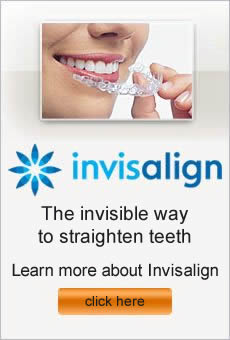If you or a loved one needs orthodontic treatment, you probably have a basic understanding of what that process entails. Most people have a concept of traditional braces and how they work to straighten teeth. Often, people have inaccurate ideas about orthodontic treatment. Understanding fact versus fiction will make your experience more pleasant.
Myth: If my braces don’t hurt, they aren’t working.
Fact: At one time, people wearing braces had to endure stiff wires, which exerted heavy pressure and caused discomfort. With modern, flexible wires, you will feel very little pain, if any, as your teeth move into the correct position.
Myth: The space between my teeth will close right away.
Fact: Once they get braces, many individuals expect the spaces to start closing immediately. It takes time for teeth to start moving.
Myth: After braces, my smile will stay perfect forever.
Fact: Your teeth are connected to bone by elastic fibers. After treatment, these fibers may try to shift the teeth back into the incorrect position. Wearing your retainer as instructed will keep your gorgeous smile intact.
Myth: My family dentist can take care of my orthodontic treatment.
Fact: Just as you wouldn’t see your general physician for a heart problem, you need to have an orthodontist assess your situation. Orthodontists have an extra two years of training in dealing with bite and alignment issues. In addition, Dr. Mehdi Fotovat and Dr. Victor Sands have been clinical instructors in the past.
Myth: Metal braces are the only option for treatment.
Fact: As orthodontic care has advanced, other choices have become available to give patients the beautiful smiles they desire. Ceramic brackets, lingual braces, and Invisalign clear aligners can allow correct misalignment and straighten teeth. After evaluating your mouth, your orthodontist will review your case and explain the best options.
Sherman Oaks, CA orthodontic practice – Mehdi Fotovat, DDS
If you child plays any type of contact sport, you need to protect their face and mouth. More than seven million injuries are sustained by individuals from ages 5 to 24 during sports-type activities. The American Association of Orthodontists (AAO) recommends that anyone who participates in these events wear a mouth guard. With a mouth guard, you can reduce the risk of concussion by 50 percent.
Mouth guard basics:
• Made from plastic materials, mouth guards cover teeth and gums. Different types of mouth guards are available: stock, boil and bite, and custom.
• Stock mouth guards are the least expensive choice, but they don’t fit very well and they offer limited protection. You can find stock mouth guards at any sporting goods store.
• A slightly better choice, boil and bite mouth appliances are placed in hot water and then allowed to mold to the shape of your teeth. Boil and bite mouth guards can also be purchased from sport goods retailers.
• Custom mouth guards offer the best coverage. These devices are designed to fit your specific teeth and gums. Your orthodontist will take a model of your teeth and send it to a dental lab to construct the custom appliance.
• Once your orthodontist receives the mouth guard from the lab, you can schedule a return appointment to check the fit.
• To care for your mouth guard, store the device in a safe place when you aren’t wearing it and clean the mouth guard with warm water after each use.
• If you have braces, ask your orthodontist about what type of mouth guard to wear to protect your mouth.
It’s time to schedule a visit to our Sherman Oaks, CA orthodontic office – Mehdi Fotovat, DDS.
Though you may have a basic understanding of orthodontic treatment, the lingo can be overwhelming. Knowing the difference between head gear and a retainer will make navigating the waters a little easier. Review the following terms to increase your orthodontic vocabulary.
Appliance
Any device the orthodontist uses to move teeth or reposition your jaw. Appliances can be fixed, like braces and expanders, or removable, like head gear and retainers.
Band
The metal ring placed on your teeth to help hold braces in place.
Biteplate
A removable or fixed device that opens a deep bite by decreasing the vertical overlap of the upper and lower incisor teeth.
Bracket
The ceramic or metal piece cemented to teeth and used as the fastening mechanism for the arch wire.
Braces
Used to align teeth and correct the bite, braces come in various forms, including metal brackets, ceramic brackets, and lingual braces, which are attached behind the teeth.
Diastema
A noticeable space between two teeth, often the front teeth.
Head gear
An orthodontic device used to move your teeth back in your mouth and create room for crowded teeth.
Invisalign aligners
The latest in orthodontic treatment options, Invisalign uses a series of clear, custom trays to gently shift teeth into place. Older teens and adult patients often choose Invisalign over traditional metal braces.
Occlusion
How your upper and lower teeth are aligned and spaced when you bite down.
Palatal Expander
Temporarily placed on the upper arch, a palatal expander helps widen the upper jaw so that the bottom and upper teeth fit together like they should.
We care about your smile at Mehdi Fotovat Sherman Oaks Orthodontist
When you have space between your teeth, also called diastema, you should consult an orthodontist about the best way to deal with this issue. Though these spaces can occur between any two teeth, they most frequently appear between the two front teeth. A diastema can be caused by a variety of factors such as:
Missing or undersized teeth
When certain teeth don’t develop or if the permanent teeth are small, a space can occur. This situation frequently happens with the upper lateral incisors, the teeth next to the two upper front teeth.
An oversized labial frenum
The piece of tissue that usually stretches from the inside of your upper lip to the gum just above your two upper front teeth, the labial frenum may sometimes grow past the two front teeth. In this case, the tissue blocks the natural closure of the teeth.
Certain habits
Thumb sucking and pacifier use can create additional space, especially between front teeth.
Periodontal disease
When gum disease progresses, the results is loss of the bone that supports the teeth, which can make teeth loose and create space.
Temporary gaps from tooth loss
As primary teeth fall out and permanent teeth erupt, young children may develop a diastema. These spaces typically close once adult teeth move into their permanent position.
If you have a diastema, your orthodontist can perform a complete evaluation. After determining the cause of the space, the doctor can devise a treatment plan to close the gap and correct any alignment issues. Once the space is corrected, you should achieve a flawless smile.
We create beautiful smiles at our orthodontic dental practice in Sherman Oaks, CA – Mehdi Fotovat, DDS
Orthodontics is the branch of dentistry concerned with prevention and correction involving irregularities of the teeth. In addition to completing dental school, orthodontists must all take an additional two to three years of specialized training. Often, general dentists will refer their patients to the orthodontist if they are concerned about malocclusion, or a bad bite.
Not only are crooked or crowded teeth not very attractive, but they can also contribute to oral health problems. Because routine home care, such as brushing and flossing, is more difficult with crowded teeth, you may be at an increased risk for issues like tooth decay and gum disease. Misalignment can also lead to added stress on the chewing muscles, causing headaches, TMJ dysfunction, or neck, shoulder, and back pain. By adjusting how teeth fit together and how your jaws line up, an orthodontist can straighten teeth and correct your bite.
The only way to determine if you need orthodontic treatment is to visit an orthodontist. During an evaluation appointment, the doctor will take a full medical and dental health history, conduct an oral exam, make impressions of your teeth, and take special X-rays and photographs. With this information, your orthodontist will be able to identify the necessary treatment and complete a comprehensive plan for creating your new, improved smile.
Orthodontic treatment can utilize various appliances and therapies to shift teeth, retrain muscles, and affect jaw growth. Most people think of braces when they hear the word orthodontics, but treatment may also involve head gear, fixed spacers, splints, and palatal expanders. The severity of the issue will determine which methods your orthodontist recommends.
Come in for an evaluation at our orthodontic dental practice in Sherman Oaks, CA – Mehdi Fotovat, DDS



